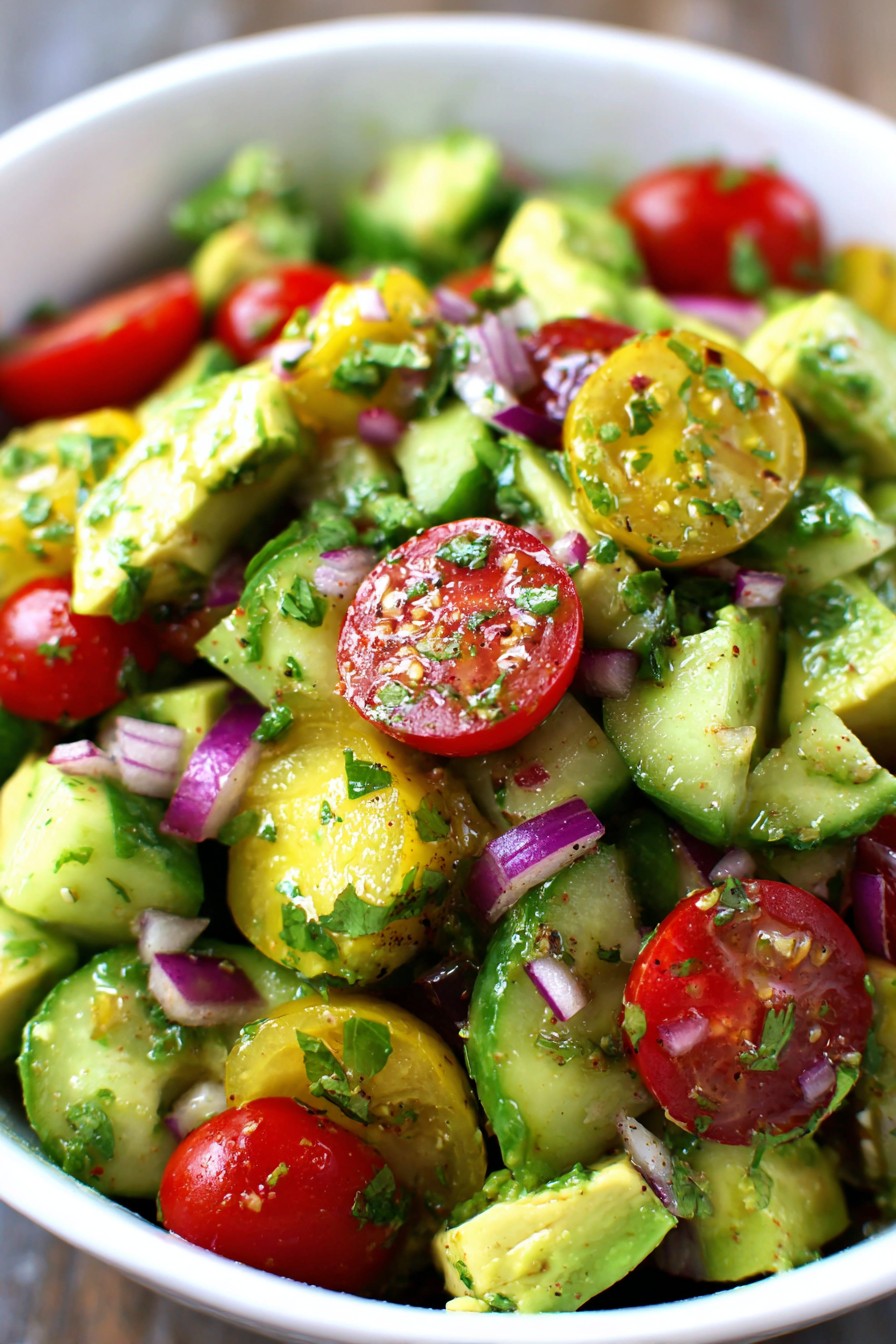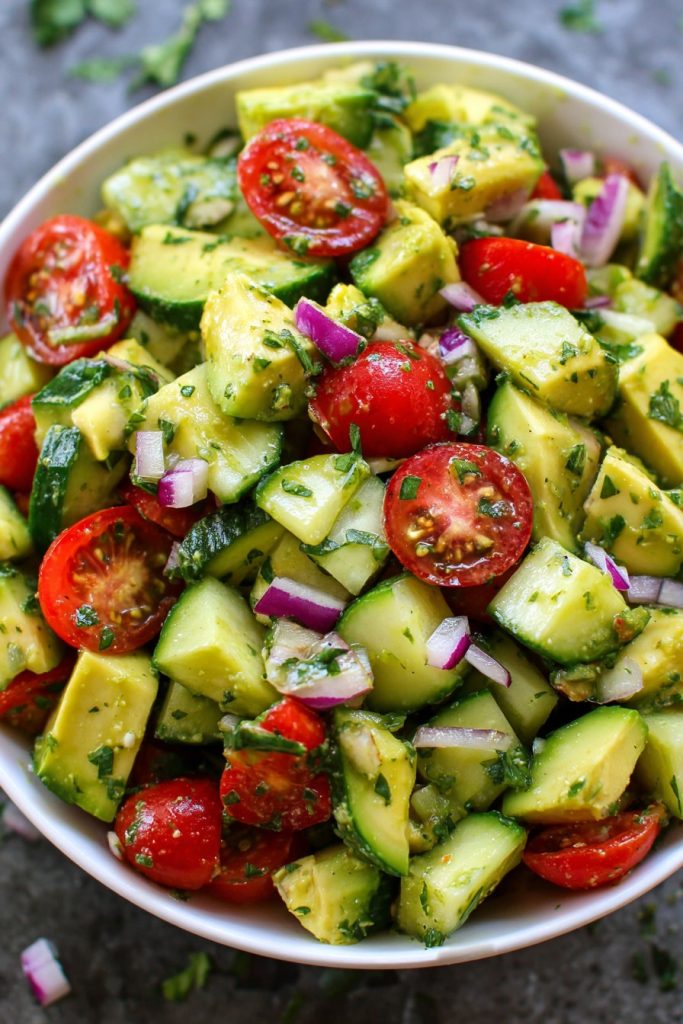Managing dinner time with hungry kids and endless to-do lists feels impossible most days, which is why this avocado salad has become my go-to solution when I need something healthy, satisfying, and ridiculously fast to throw together. Many weeknights leave me scrambling to put something decent on the table, and this recipe has saved me more times than I can count because it requires minimal effort while delivering maximum flavor and nutrition that even my pickiest eater will actually eat without complaint.
Why This Recipe Works
- This salad comes together in under 15 minutes from start to finish, making it perfect for those chaotic evenings when you’re juggling homework, extracurricular activities, and still need to get dinner on the table without losing your mind over complicated preparations or lengthy cooking times.
- Using just one bowl for mixing means you’re not creating a mountain of dirty dishes that will haunt you after the kids are finally in bed, and the simple dressing requires no separate whisking container since everything gets tossed together right in the main salad bowl.
- The creamy avocado acts as a natural dressing thickener when mashed slightly, eliminating the need for complicated emulsion techniques while providing healthy fats that keep everyone full and satisfied longer than typical leafy salads that leave kids hungry an hour later.
- All ingredients are easily customizable based on what you have in your pantry or fridge, allowing you to use up leftover vegetables or adapt to different family preferences without needing special grocery store trips during your already packed schedule.
- The combination of textures from crisp cucumbers to creamy avocado and juicy tomatoes keeps things interesting for both adults and children, while the bright lime dressing cuts through the richness without overwhelming young palates with sharp flavors.
Ingredients
- 3 ripe avocados, peeled, pitted, and cubed
- 1 English cucumber, diced with skin on
- 2 cups cherry tomatoes, halved
- 1/2 red onion, finely diced
- 1/4 cup fresh cilantro, chopped
- 3 tablespoons fresh lime juice
- 2 tablespoons extra virgin olive oil
- 1 teaspoon honey
- 1/2 teaspoon salt
- 1/4 teaspoon black pepper
Equipment Needed
- Large mixing bowl
- Cutting board
- Sharp knife
- Measuring spoons
- Vegetable peeler (optional)
Instructions

Prepare Your Vegetables Efficiently
Start by washing all your produce thoroughly under cool running water since we’re keeping most of the skins on for added nutrition and time savings. Take your English cucumber and slice it lengthwise down the middle, then cut each half into quarter-inch thick half-moons – this shape makes them easier for kids to pick up and eat while providing nice texture contrast. For the cherry tomatoes, place them between two plastic container lids to hold them steady while you slice through the entire batch at once with a sharp knife, saving you from handling each tiny tomato individually. The red onion should be peeled and sliced into very thin half-moons rather than diced, as this milder presentation tends to be more acceptable to family members who normally protest against onions in their food. Pro tip: If you’re really pressed for time, many grocery stores now carry pre-diced onions and other vegetables in the refrigerated section that can shave precious minutes off your prep work.
Combine Your Base Ingredients
Grab your largest mixing bowl – I recommend one that’s at least 4 quarts capacity to give you plenty of room for tossing without making a mess on your countertops. Add your prepared cucumber pieces, halved cherry tomatoes, and thinly sliced red onion directly into the bowl, taking care not to crush the tomatoes as you add them. Now take your three ripe avocados and slice them in half lengthwise around the pit, twist to separate, then carefully tap your knife into the pit and twist to remove it safely. Use a spoon to scoop the avocado flesh from the skin in large chunks rather than trying to peel it, as this method preserves more of the creamy texture and prevents bruising. Gently fold these avocado chunks into the vegetable mixture using a large rubber spatula or your hands, being careful not to overmix and turn everything to mush.
Create the Simple Dressing
In a small measuring cup or right in the empty half of your large mixing bowl if you’re trying to minimize dishes, combine the fresh lime juice, extra virgin olive oil, honey, salt, and black pepper. The honey is crucial here not just for sweetness but for helping emulsify the dressing naturally without needing to whisk vigorously – just stir with a fork until the honey dissolves into the lime juice. Taste this mixture on a piece of lettuce or cucumber and adjust seasoning if needed, remembering that flavors will intensify once mixed with the avocado. If your family prefers milder flavors, start with half the lime juice and add more gradually until it reaches their preference. Pro tip: Squeeze your limes more efficiently by rolling them firmly on the countertop before cutting, which breaks down the internal membranes and yields significantly more juice with less effort.
Assemble and Toss the Salad
Pour your prepared dressing over the vegetable and avocado mixture in the large bowl, then add the freshly chopped cilantro right on top. Using two large spoons or salad tongs, gently lift and turn the ingredients from the bottom of the bowl upward, repeating this motion until everything is evenly coated with the dressing. The goal here is to distribute the flavors without crushing the avocado chunks completely – some slight mashing is fine and actually helps create a creamier coating on the other vegetables. Pay special attention to incorporating the red onion slices evenly throughout, as they tend to clump together when wet. This entire tossing process should take no more than 30-45 seconds to prevent the salad from becoming too watery.
Serve Immediately with Smart Presentation
Transfer your finished avocado salad to a serving platter or individual bowls right away, as the acid in the lime juice will begin breaking down the vegetables if left sitting too long. For families with varying taste preferences, consider serving the salad with extra lime wedges on the side so everyone can adjust the acidity to their liking. If you’re dealing with particularly picky eaters, you can serve the components separately and let them build their own plates – this often works wonders with children who want control over their food. Pro tip: For next-day leftovers, store the salad in an airtight container with a piece of plastic wrap pressed directly against the surface to limit air exposure and prevent browning. The salad remains edible for about 24 hours though the texture will soften considerably.
Tips and Tricks
When selecting avocados for this recipe, look for ones that yield slightly to gentle pressure but don’t feel mushy – if you can only find rock-hard avocados, place them in a paper bag with a banana overnight to speed up ripening naturally. For even faster preparation, consider using kitchen shears to chop herbs like cilantro directly over the bowl, saving you both cutting board space and cleanup time. If your family members dislike raw onion, try soaking the sliced red onion in ice water for 10 minutes before adding to the salad – this simple trick removes some of the sharp bite while maintaining the crunch and flavor. When dealing with varying texture preferences, you can mash one avocado completely to create a creamier base while keeping the other two in chunks for those who prefer distinct pieces. For maximum efficiency, prep your vegetables during naptime or while waiting for pasta water to boil earlier in the day, storing them in separate containers in the refrigerator until dinner assembly. If you’re making this salad ahead for potlucks or busy weeknights, prepare all components except the avocado and dressing, then combine everything just before serving to maintain optimal texture. For families dealing with cilantro aversion due to genetic taste perceptions, fresh parsley or basil make excellent substitutes that provide similar freshness without the polarizing flavor. When measuring sticky ingredients like honey, lightly oil your measuring spoon first to ensure every drop slides out easily and nothing gets wasted. If your cherry tomatoes are particularly juicy, consider scooping out some of the seeds and gel before halving to prevent excess liquid from watering down your dressing. For added protein that makes this salad a complete meal, canned chickpeas or black beans rinsed and drained work beautifully and require zero additional cooking time. Always taste your salad after tossing and before serving to adjust seasoning – sometimes the avocado can mute the saltiness, requiring a final pinch to brighten everything up properly.
Recipe Variations
- For a heartier main dish salad that can stand alone as dinner, add one 15-ounce can of drained and rinsed black beans along with one cup of cooked corn kernels (thawed frozen works perfectly). The beans add plant-based protein that keeps everyone full longer while the corn provides sweet pops of flavor that children particularly enjoy. This variation also stretches the salad to feed more people or provide leftovers for lunch the next day without significantly increasing your prep time.
- Transform this into a Mediterranean-inspired version by substituting the cilantro with fresh chopped parsley and adding 1/2 cup of crumbled feta cheese and 1/4 cup of chopped Kalamata olives. The salty brininess of these ingredients pairs wonderfully with the creamy avocado while introducing new flavors that might appeal to adults looking for something more sophisticated. Serve this variation with pita chips or warm pita bread for dipping to make it more substantial.
- Create a tropical twist perfect for summer meals by replacing the cherry tomatoes with 1 cup of diced mango and 1/2 cup of toasted coconut flakes. Use lemon juice instead of lime and add a pinch of chili powder to the dressing for subtle heat that balances the sweetness. This variation works particularly well alongside grilled chicken or fish and feels like a special treat without requiring significantly more effort than the original recipe.
- For a creamier, dip-like consistency that doubles as a vegetable platter accompaniment, mash all the avocados completely and reduce the cucumber to 1/2 cup finely diced. Increase the lime juice to 1/4 cup and add 1/4 cup of Greek yogurt for tanginess and extra protein. This version spreads beautifully on toast or serves as a sophisticated dip for carrot sticks, bell pepper strips, and crackers during snack time or light lunches.
- Make it a protein-packed meal salad by adding 2 cups of cooked shredded chicken (rotisserie chicken works perfectly) and 1/4 cup of toasted pumpkin seeds for crunch. Use an orange juice and olive oil dressing instead of lime to complement the chicken flavor, and consider adding some baby spinach leaves for extra greens. This variation essentially becomes a complete balanced meal in one bowl, eliminating the need to prepare separate side dishes during particularly hectic evenings.
Frequently Asked Questions
How do I prevent the avocado from turning brown if I need to make this salad ahead of time?
The most effective method for preventing browning is to store the salad with the avocado pit placed right in the center of the container – the pit contains enzymes that slow oxidation. Additionally, press a piece of plastic wrap directly against the surface of the salad before sealing the container lid, which limits air exposure significantly. The acid in the lime juice also helps slow browning, so ensure your dressing is well distributed. For best results, I recommend preparing the other ingredients ahead but adding and tossing with the avocado no more than 2 hours before serving to maintain ideal texture and appearance while still saving some prep time.
Can I use frozen or canned vegetables to save even more time on this recipe?
While fresh vegetables provide the best texture for this particular salad, you can certainly use thawed frozen corn or canned beans as additions without compromising quality. For the main components like cucumbers and tomatoes, I’d stick with fresh as frozen become too watery when thawed and canned lack the crispness needed for contrast. Cherry tomatoes actually freeze quite well whole – when thawed, they’re perfect for cooking but too soft for salads. If time is extremely limited, many grocery stores now offer pre-diced fresh vegetable mixes in the refrigerated section that work beautifully here.
What can I substitute if my family doesn’t like cilantro or I can’t find it?
Fresh flat-leaf parsley makes an excellent substitute that provides similar freshness without the distinctive cilantro flavor that some people find soapy due to genetic factors. Basil also works wonderfully, especially if you’re making the Mediterranean variation, though it has a stronger personality that might overwhelm other ingredients if used in the same quantity. For a completely different direction, try using fresh dill which pairs surprisingly well with avocado and lime. If you have no fresh herbs available, 1 teaspoon of dried oregano mixed into the dressing can provide some herbal notes, though the texture will obviously differ.
How can I make this salad more appealing to very picky eaters, especially children?
Presentation matters tremendously with hesitant eaters – try serving the components separately in a “salad bar” style arrangement so they can choose what to include on their own plate. Sometimes simply cutting the vegetables into different shapes using cookie cutters makes them more appealing. You can also blend the dressing with one avocado to create a creamy dip-like consistency that might be more familiar and acceptable. Another strategy involves renaming the dish something fun like “Green Power Bowl” or “Superhero Salad” to make it more exciting before they even taste it.
Is this salad substantial enough to serve as a main course for dinner?
While the basic version works best as a side dish, you can easily transform it into a complete meal by adding protein sources like canned beans, grilled chicken strips, hard-boiled eggs, or chickpeas. For additional staying power, serve it over a bed of quinoa or brown rice that you can cook ahead of time. The healthy fats in the avocado do provide considerable satisfaction, but growing children and active adults typically need more substantial additions to call it dinner. I often double the recipe and add two cans of beans when serving it as our main evening meal.
Summary
This avocado salad delivers maximum flavor with minimal effort, using simple ingredients that come together in one bowl for easy cleanup. The creamy texture and bright dressing appeal to both adults and children while providing healthy fats and fresh vegetables. Customizable variations make it adaptable for different tastes and occasions without complicating the straightforward preparation process that busy families need.
Easy Avocado Salad
4
servings15
minutesIngredients
Instructions
- 1 Wash all produce thoroughly. Slice cucumber into half-moons, halve cherry tomatoes, and thinly slice red onion.
- 2 Combine cucumber, tomatoes, and onion in large mixing bowl. Add avocado chunks and gently fold together.
- 3 Whisk together lime juice, olive oil, honey, salt, and pepper in small container or directly in bowl.
- 4 Pour dressing over salad ingredients, add cilantro, and toss gently until evenly coated.
- 5 Serve immediately or store with plastic wrap pressed directly against surface for short-term storage.



